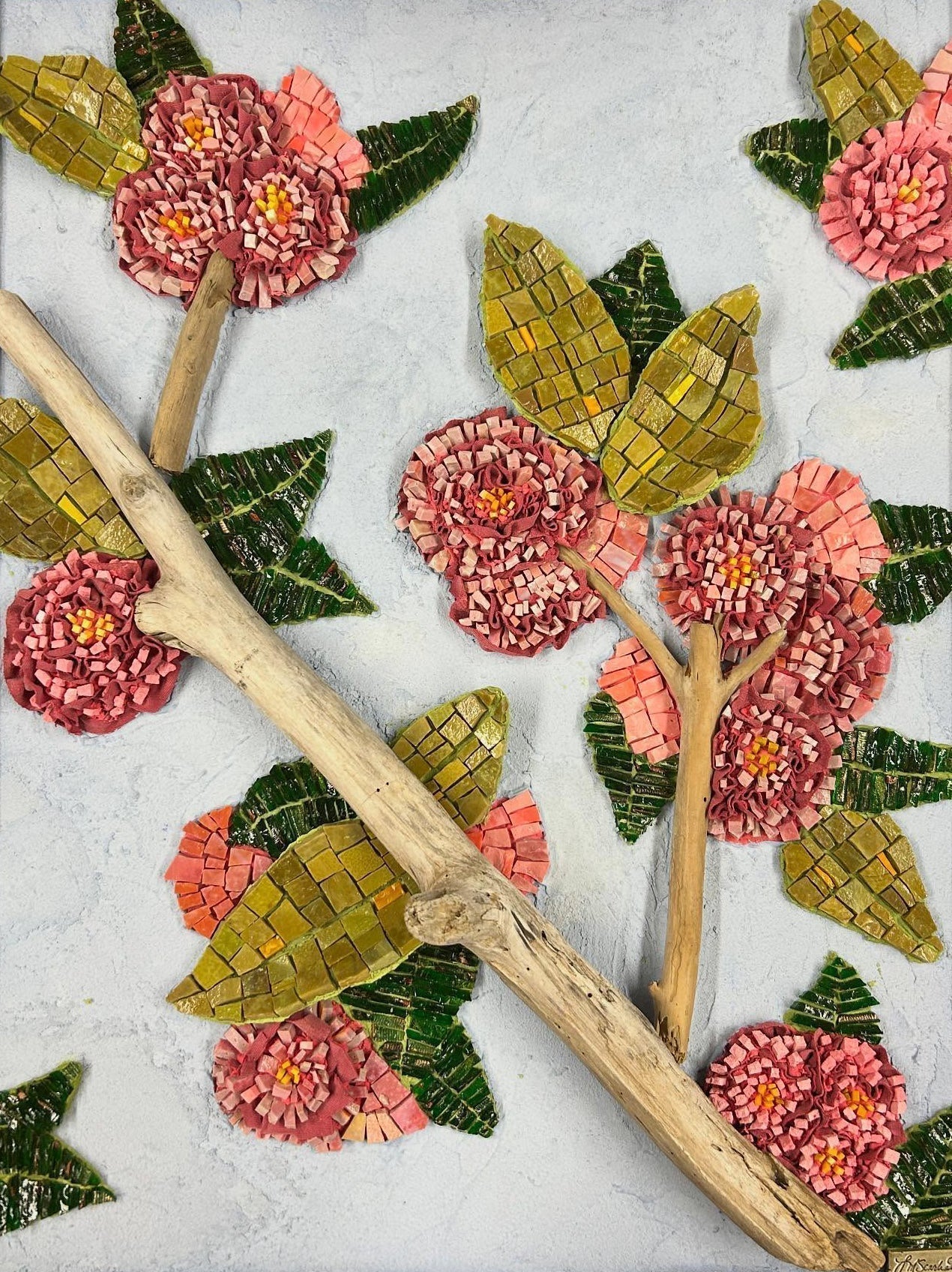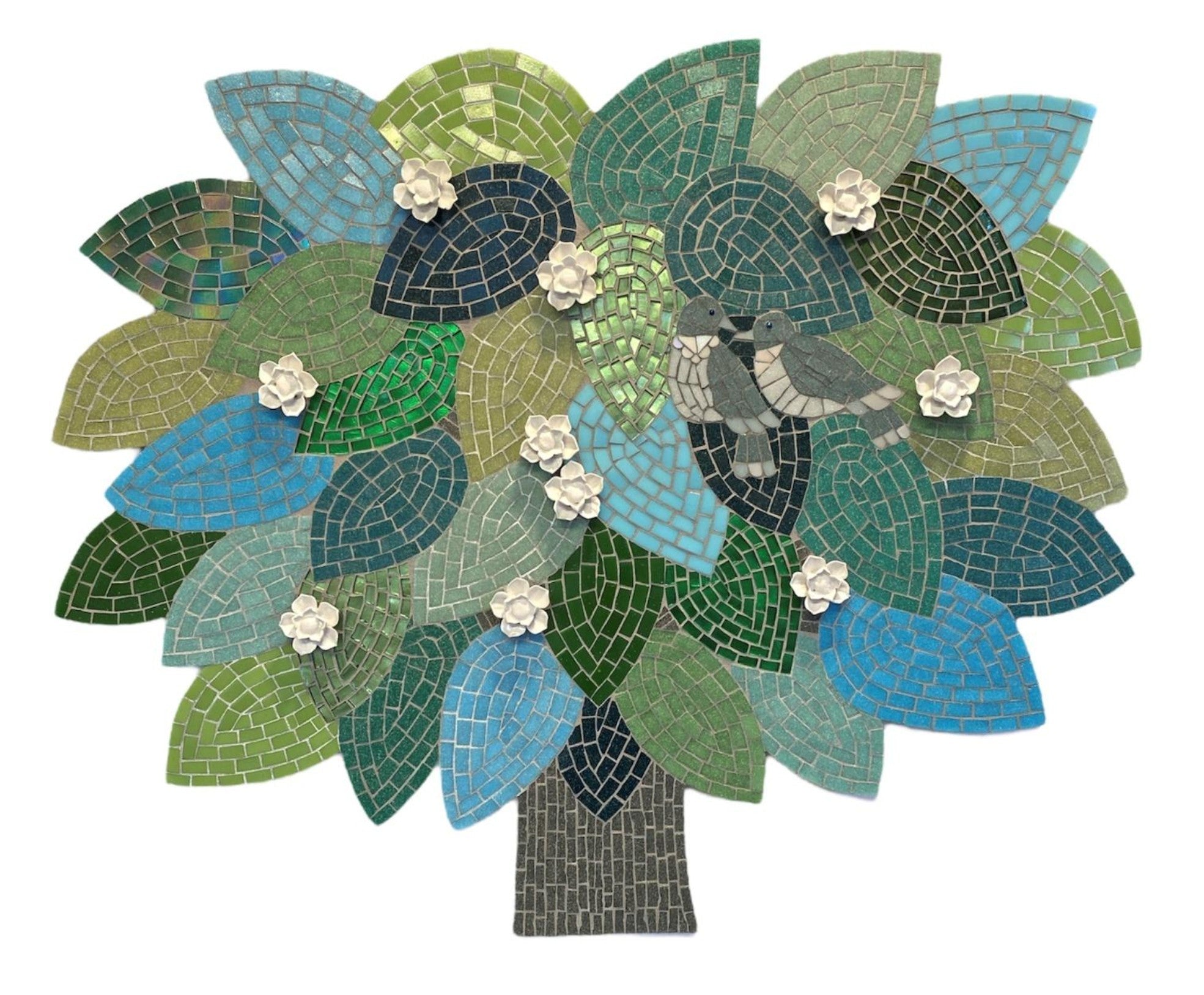The mosaic works of Gila Rayberg are as easily identifiable and unique as her name! I can remember seeing Gila’s mosaics on Flickr years ago, and admiring the ease and playfulness of her of her subjects, colors, and tessellation. A few days ago I had the pleasure of talking with Gila for the first time after having known her work for years via the intranet.
One thing I learned from our conversation is that Gila is an accomplished musician. This made perfect sense to me when Gila shared her experience with travel, educating, and art forms. Although I consider Fickr one of the greatest eye candy resources, Gila’s work takes on the additional facets of having rhythm and motion without traditional andamento or tessellation.
Gila’s work does not evoke emotion so much for me as it does the desire to physically move. Although I find many of her works thought provoking, ponderance is only secondary to the desire to dance, hold the subject’s hand, give them a hug, skip in delight, or simply follow their lead.
Below are the questions posed to Gila and her responses. They are a great insight to her creative process, as well as getting to know more about her, which I believe, are intrinsically linked. 
LMA: Tell us about your creative process…
Gila: The way I approach my work is highly intuitive. Once I have my subject and a general idea of where I want to go I allow the materials to guide me. I don't have a formulaic approach or process that I follow each time, rather I continue to develop my process through experimentation and lessons learned from what did or didn't work in previous mosaics.
LMA: How did you get started in mosaic art?
Gila: My first exposure to mosaics was when I was a teenager visiting my sister's studio (mosaic artist, Elizabeth Raybee) where I helped her grout a large mosaic installation and created a few small pieces of my own. That's where I first got hooked, but put on the shelf for many years, almost two decades, while I pursued my music career. I've been creating mosaics full-time since 2005, just after Hurricane Katrina. 
LMA: What are some of your favorite materials and what do like about them?
Gila: Over the past few years I've become more and more fascinated with portraiture, finding it highly challenging and never boring. Since beginning to work with dinnerware and pottery it's opened up a whole new level of history and storytelling that often runs throughout the mosaic work. Individual pieces of pottery and dishes may have a history of their own. Maybe they have been given to me by a friend, my own grandmother, found at a thrift store or yard sale, each has their own back story. While working on a portrait, I'm constantly on the look out for how bits of patterns words and designs from my "picassiette" stash can help to tell my subject's story and enhanced expression.
LMA: Explain what drives you to create…
Gila: I'm not exactly sure what drives me to create. I love working with my hands and composing uniquely original artworks from bits and pieces of dinnerware & other discarded shards. The use of dishes and pottery also known as picassiette, has become a real passion, in part because of the ever-changing materials and endless possibilities they hold. It's also really fun to find new ways to employ the textural elements found in dishes, teacups and the like. In addition to faces, hands have become increasingly important in my work and I love using the under side ridged portion of dishes as the "bones", to bring them to life. 
LMA: What would you like readers to know about and your artwork?
Gila: Over the last few years I've begun to do a lot more drawing. When I see a person, photo, or scene that inspires me I'll do a quick sketch. On many occasions those sketches are the starting point for my mosaic portraits.
I started drawing in earnest after joining a group called Julia Kay's Portrait Party, an online group of artist drawing portraits of each other, making each member both model and artist. My continued interactions with these other artists, has become a driving force and primary reference source for my portraits. 
LMA: What is your favorite thing you have created and why?
Gila: I don't really have a favorite mosaic but there are several that have become part of my own personal collection. One of those pieces is my "Textile Throne". Driving around the streets of New Orleans after Hurricane Katrina I spotted a small chair amid all of the debris on the side of the road. I immediately thought it would make a perfect mosaic chair, so back to my studio it came. After several months of preparation using a moisture barrier fiberglass and concrete mixture, the chair was ready for its mosaic covering. I decided to use a variety of designs inspired by Malaysian and Indonesian batik textiles to "upholster" its surface. (I lived in and taught music in Malaysia for 3 years, during which time, I collected textiles & indigenous musical instruments) About midway through the mosaic process we relocated, so I had to pack it up, along with my entire mosaic studio (no easy task). I finally completed work, about a year later, and my new Florida home/studio. The throne lives in my backyard and I love seeing it every day. Everyone who visits comments on how comfortable it looks, just like a real cushioned chair, and it is!
One of the things that differentiate my work from other more traditional mosaics is the use of large and irregular shaped tesserea, especially when working with picassiette. This allows me to incorporate patterns and designs found on the dinnerware. 
LMA: Please share a favorite mosaic experience with us.
Gila: Recently I had an awesome music experience when I received a letter for commission to create a portrait of my former New Orleans home! The house was on the market again and the new owner fell in love with all the mosaics she found inside and around the house. They were some of my earliest mosaic installations done while I was still working full-time as a freelance musician. It was a thrill to know that those artworks, that a realtor had told me would make the house difficult to sell, were once again a welcome bonus for the new owner! It was a heart warming and nostalgic process working on that house, which included a simplified replica of the "faux" mosaic door I created post Katrina. 
The first mosaic portrait I saw of Gila’s was one entitled, “The Morning After”. I asked her if she felt this particular piece was a catalyst for her artistic direction towards focusing on mosaic portraiture. She did not readily answer either way. She took a moment to think about it and with the slightest bit of almost accidental conviction she answered along the lines of, “I guess so…well, maybe…yeah.” Within minutes of hanging up, I received a nice email from Gila reading in part, “My partner Mark agrees with you that "The Morning After" was a break through artwork for me!”
Another fun fact about Gila I will share is that Gila was the first recipient of the SAMA Robin Brett Scholarship! Although I believe we never stop learning, Gila continues to teach as well, giving away what she has been given, making room to receive the next gift in life. Thank you Gila, for the gifts you share with us all! Wonderful how the universe works isn’t it?










